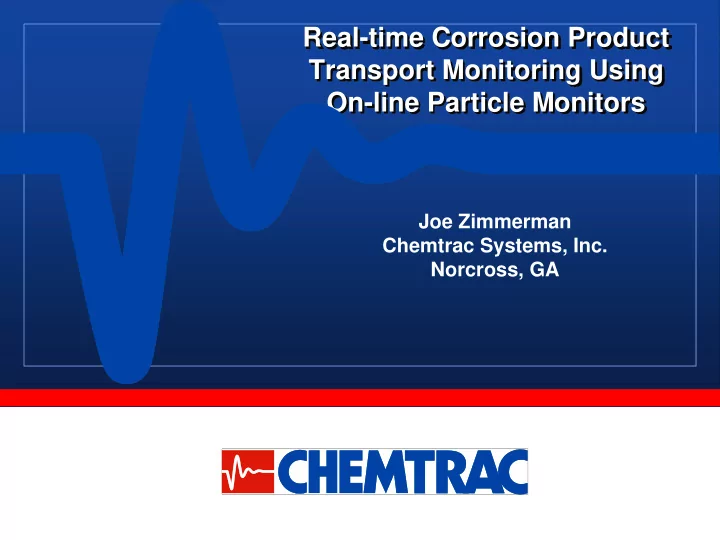

Real-time Corrosion Product Transport Monitoring Using On-line Particle Monitors Joe Zimmerman Chemtrac Systems, Inc. Norcross, GA
Introduction The goal of CPT monitoring is to determine: � when corrosion is occurring � where corrosion is occurring � how much corrosion is occurring
Introduction The ability to monitor CPT in real-time will allow for: � System control actions to be taken based on the current corrosion product levels � Measurement of the effects of the adjustments on the corrosion product levels
Introduction Overview � Steam Cycle Monitoring � Particle Detection Technology � CPT Particle Monitoring � Conclusions
Steam Cycle Monitoring
Steam Cycle Monitoring Traditional Methods � Soluble - Grab sample tests � Metals analysis, various other lab analyses - On-line analyzers � Cation conductivity, sodium, silica, pH, etc. - Composite sampling � Ion exchange columns, resin-impregnated filter pads
Steam Cycle Monitoring Traditional Methods � Insoluble - Grab sample tests � Millipore pads, TSS, lab particle analyses - On-line analyzers � Turbidity monitors - Composite sampling � Corrosion Product Monitor filter pads
Steam Cycle Monitoring On-line Particle Analysis � provides real-time indication of insoluble particulate loading � allows for continuous data collection & trending
Particle Detection Technology
Particle Detection Technology � Turbidity Monitors utilize a “light scattering” measurement � Particle Counters & Particle Monitors utilize a “light blockage” measurement
Particle Detection Technology Turbidity Monitor Lens Lamp 0.30 NTU 0.00 NTU Photo Detector
Particle Detection Technology Particles Light Beam Laser Diode Photo Diode Or LED Water Flow
Particle Detection Technology Particle Counter & Particle Monitor � Detect particles > 2 microns � 1 particle/mL sensitivity � <10 PPT detection capability
Particle Detection Technology Particle Counter � Reports results in counts/mL for up to 8 size ranges � Allows for size/count distribution profiles
Particle Detection Technology Particle Monitor � Single channel device, producing a “relative” measurement called a Particle Index (PI) � The PI will increase with both an increase in particle size and concentration
Particle Detection Technology Particle Counter, Particle Monitor, Turbidity Monitor INSTRUMENT COMPARISON USING AC FINE TEST DUST 500 0.3 Particle Counter 450 Particle Monitor PARTICLE Cnts/mL - PARTICLE INDEX Turbidimeter 400 350 How Are Particles Detected? 0.2 TURBIDITY (NTU) 300 250 200 0.1 150 100 50 0 0 Particle Counter 21 48 75 106 200 300 390 440 50 150 170 200 300 390 460 470 Particle Monitor 0.05 0.05 0.05 0.05 0.06 0.06 0.07 0.07 Turbidimeter
Particle Detection Technology Magnetite
Particle Detection Technology Hematite
CPT Particle Monitoring
CPT Particle Monitoring Steam Generation Cycle
CPT Particle Monitoring Particle Counts During Load Change
CPT Particle Monitoring HRSG 1 MW HRSG 1 MW, HRSG 2 MW HRSG 1 MW, HRSG 2 MW, Particle Index
CPT Particle Monitoring Condensate Condensate pH, Condensate pH, Cation Conductivity, Condensate pH, Cation Conductivity & Particles
CPT Particle Monitoring Condensate DO, Condensate DO, ORP Condensate DO, ORP, & Particles
CPT Particle Monitoring Nuclear Plant – Iron Transport Data
CPT Particle Monitoring Fossil Plant – CPM Iron vs. Particle Index Average
CPT Particle Monitoring Fossil Plant – CPM Iron vs. Particle Index Average
CPT Particle Monitoring Fossil Plant – CPM Iron vs. Particle Index Average
Conclusions
Conclusions On-line Particle Monitoring: � Provides continuous tracking of insoluble metal oxides…a clear advantage over “grab” or “composite” sampling � Complements existing online ionic analyzers, offering additional analytical trends for system performance evaluation � Offers real-time CPT results…treatment program adjustments can be made, and subsequent effects on CPT levels can be measured � Allows for real-time recognition of CPT “events” such that immediate actions can be considered when an event occurs
Recommend
More recommend